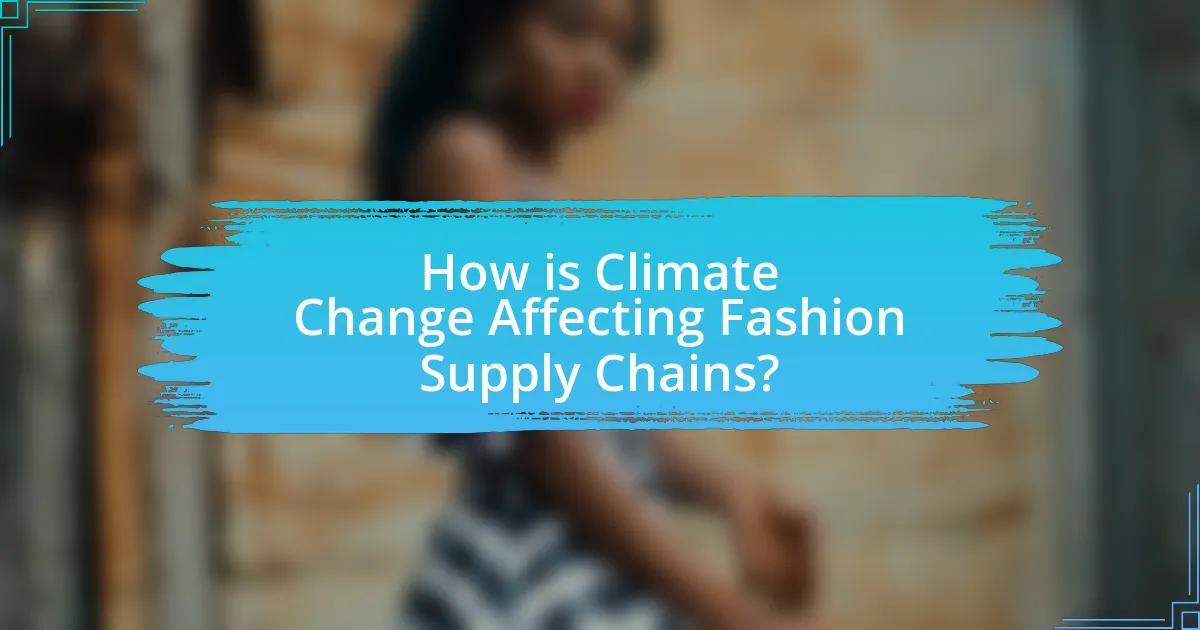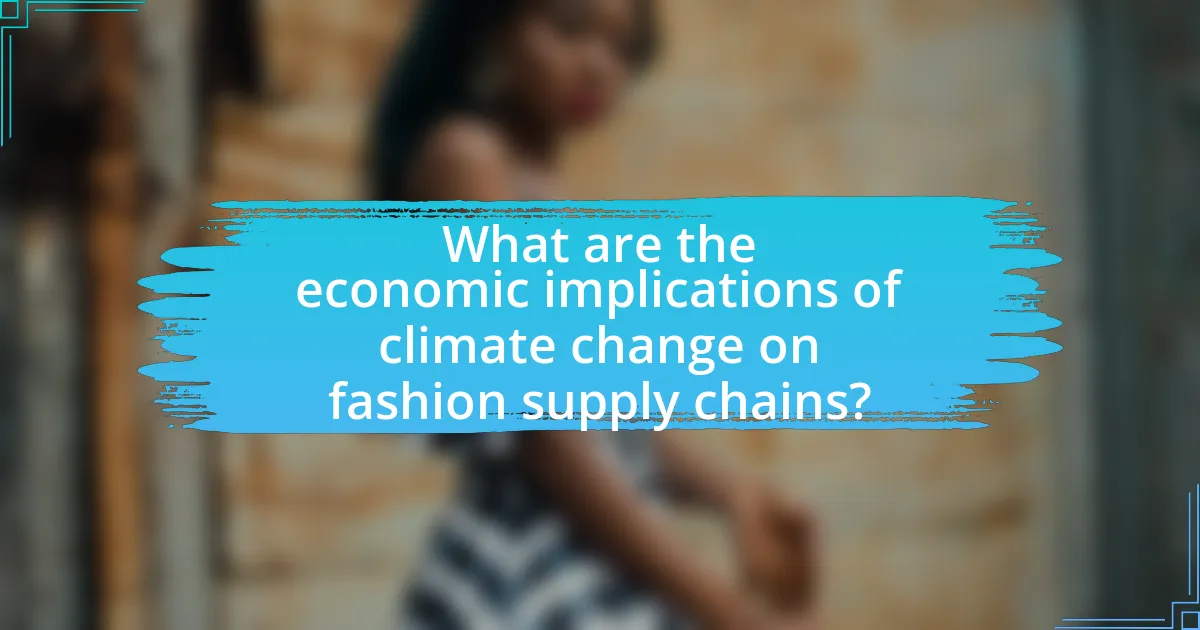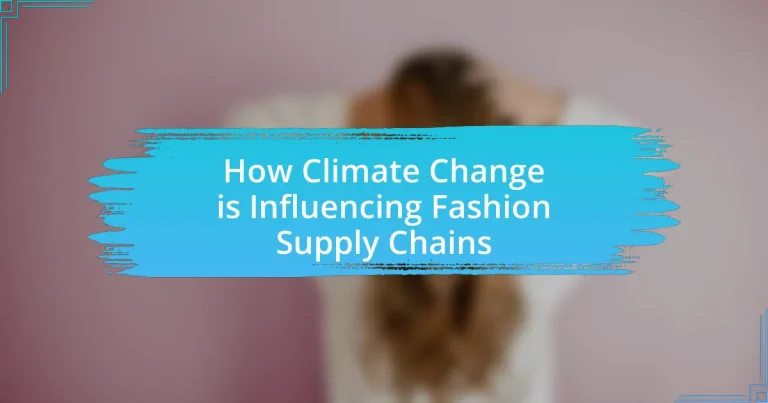Climate change is profoundly impacting fashion supply chains by causing resource scarcity, increasing production costs, and altering consumer demand. Extreme weather events disrupt the availability of raw materials, such as cotton and wool, leading to significant economic implications for the industry. As brands face rising operational costs and regulatory pressures, sustainability has become crucial, prompting a shift towards eco-friendly practices and materials. The article explores the various ways climate change affects production, sourcing strategies, and consumer behavior, while highlighting the importance of transparency and circular economy principles in mitigating these challenges.

How is Climate Change Affecting Fashion Supply Chains?
Climate change is significantly disrupting fashion supply chains by causing resource scarcity, altering production timelines, and increasing costs. Extreme weather events, such as floods and droughts, impact the availability of raw materials like cotton and wool, leading to supply shortages. For instance, the World Bank reported that climate change could reduce global agricultural yields by up to 25% by 2050, directly affecting the textile industry. Additionally, rising temperatures and changing precipitation patterns can delay production processes, as manufacturers struggle to adapt to new environmental conditions. This unpredictability results in increased operational costs, which are often passed on to consumers, further complicating the economic landscape of the fashion industry.
What are the primary impacts of climate change on fashion supply chains?
Climate change significantly impacts fashion supply chains by disrupting production, increasing costs, and altering consumer demand. Extreme weather events, such as floods and droughts, can damage crops used for natural fibers, leading to shortages and higher prices. Additionally, rising temperatures can affect the availability of water resources essential for textile manufacturing, further straining supply chains. According to a report by the Global Fashion Agenda, climate-related disruptions could cost the fashion industry up to $65 billion annually by 2030. Furthermore, consumers are increasingly prioritizing sustainability, prompting brands to adapt their supply chains to meet new environmental standards and expectations.
How do extreme weather events disrupt production and distribution?
Extreme weather events disrupt production and distribution by causing significant delays and damage to supply chains. For instance, hurricanes can halt manufacturing operations, as seen during Hurricane Harvey in 2017, which led to widespread factory closures in Texas, impacting the production of various goods. Additionally, flooding can damage transportation infrastructure, making it difficult to deliver products to retailers. A study by the National Oceanic and Atmospheric Administration (NOAA) indicates that extreme weather events have increased in frequency, leading to an estimated economic loss of $306 billion in the U.S. from 2000 to 2019, highlighting the financial impact on production and distribution networks.
What role does resource scarcity play in supply chain management?
Resource scarcity significantly impacts supply chain management by forcing companies to adapt their sourcing strategies and operational processes. As natural resources become limited due to climate change, businesses face increased costs and supply disruptions, which necessitate a reevaluation of their supply chain practices. For instance, the fashion industry has seen a rise in the use of sustainable materials and practices as a response to the scarcity of water and raw materials, which are critical for production. According to a report by the Ellen MacArthur Foundation, the fashion industry could save $500 billion by adopting circular economy principles that address resource scarcity. This shift not only mitigates risks associated with resource depletion but also aligns with consumer demand for sustainable practices.
Why is sustainability becoming crucial in fashion supply chains?
Sustainability is becoming crucial in fashion supply chains due to increasing consumer demand for environmentally responsible practices and the urgent need to mitigate climate change impacts. The fashion industry is one of the largest contributors to global pollution, accounting for approximately 10% of annual carbon emissions, which necessitates a shift towards sustainable practices to reduce environmental harm. Furthermore, regulatory pressures and the potential for financial risks associated with unsustainable practices are driving brands to adopt sustainable sourcing, production, and distribution methods. This shift not only addresses ecological concerns but also aligns with consumer preferences, as studies show that 66% of global consumers are willing to pay more for sustainable brands.
How does consumer demand for sustainable practices influence supply chains?
Consumer demand for sustainable practices significantly influences supply chains by prompting companies to adopt eco-friendly materials and processes. As consumers increasingly prioritize sustainability, brands are compelled to source organic, recycled, or ethically produced materials to meet these expectations. For instance, a 2021 survey by McKinsey found that 67% of consumers consider sustainability when making purchasing decisions, leading companies to integrate sustainability into their supply chain strategies. This shift not only enhances brand loyalty but also drives innovation in sustainable practices, such as reducing waste and carbon emissions throughout the supply chain.
What are the environmental regulations affecting the fashion industry?
Environmental regulations affecting the fashion industry include the European Union’s REACH regulation, which restricts hazardous substances in textiles, and the California Transparency in Supply Chains Act, which mandates disclosure of supply chain practices related to environmental impact. These regulations aim to reduce pollution, promote sustainable practices, and ensure transparency in sourcing materials. For instance, REACH requires companies to register chemical substances used in their products, ensuring they meet safety standards, while the California Act encourages brands to assess and disclose their environmental practices, fostering accountability.
How are fashion brands adapting to climate change challenges?
Fashion brands are adapting to climate change challenges by implementing sustainable practices and innovative technologies. Many brands are shifting towards eco-friendly materials, such as organic cotton and recycled polyester, to reduce their carbon footprint. For instance, brands like Patagonia and H&M have committed to using 100% sustainable cotton by 2025. Additionally, companies are investing in supply chain transparency and circular economy models, which promote recycling and reusing garments. According to a report by McKinsey & Company, 67% of fashion executives believe that sustainability will be a key driver of growth in the coming years, highlighting the industry’s recognition of climate change as a critical factor influencing business strategies.
What innovative practices are being implemented in supply chains?
Innovative practices being implemented in supply chains include the adoption of circular economy principles, advanced data analytics, and sustainable sourcing strategies. Circular economy practices focus on reducing waste by reusing materials and designing products for longevity, which is increasingly important in the fashion industry facing climate change challenges. Advanced data analytics enables real-time tracking of inventory and demand forecasting, improving efficiency and reducing overproduction. Sustainable sourcing strategies prioritize environmentally friendly materials and ethical labor practices, aligning with consumer demand for transparency and sustainability. These practices are supported by industry reports indicating that companies adopting such innovations can reduce their carbon footprint and enhance resilience against climate-related disruptions.
How are brands collaborating with suppliers to enhance resilience?
Brands are collaborating with suppliers to enhance resilience by implementing shared risk management strategies and investing in sustainable practices. This collaboration includes joint efforts to diversify sourcing locations, which mitigates the impact of climate-related disruptions. For instance, brands are working with suppliers to adopt eco-friendly materials and processes, thereby reducing their carbon footprint and increasing supply chain sustainability. According to a report by McKinsey & Company, companies that engage in collaborative sustainability initiatives with suppliers can improve their operational resilience by up to 30%. This partnership approach not only strengthens supply chain stability but also aligns with consumer demand for environmentally responsible practices.

What are the economic implications of climate change on fashion supply chains?
Climate change significantly impacts fashion supply chains by increasing costs and disrupting production. Extreme weather events, such as floods and droughts, can damage crops used for natural fibers, leading to reduced availability and higher prices for materials like cotton and wool. According to the Global Fashion Agenda’s 2021 report, climate-related disruptions could cost the fashion industry up to $65 billion annually by 2030. Additionally, regulatory changes aimed at reducing carbon emissions may impose further financial burdens on manufacturers, compelling them to invest in sustainable practices and technologies. These economic implications necessitate a reevaluation of supply chain strategies to mitigate risks and adapt to the evolving climate landscape.
How does climate change affect the cost of raw materials?
Climate change increases the cost of raw materials due to supply chain disruptions and resource scarcity. Extreme weather events, such as droughts and floods, can damage crops and reduce yields, leading to higher prices for agricultural raw materials. For instance, the 2021 drought in Brazil significantly impacted coffee production, causing prices to rise by over 50%. Additionally, climate change can affect the availability of natural resources like water and minerals, further driving up costs. The increased frequency of natural disasters also leads to higher transportation costs and delays, compounding the financial impact on raw material prices.
What trends are emerging in pricing due to climate-related factors?
Emerging trends in pricing due to climate-related factors include increased costs for raw materials, shifts in consumer demand towards sustainable products, and the implementation of carbon pricing mechanisms. The fashion industry is experiencing higher prices for materials like cotton and wool, driven by climate-induced supply disruptions and water scarcity. Additionally, consumers are increasingly willing to pay a premium for eco-friendly products, influencing brands to adjust their pricing strategies accordingly. Furthermore, regulatory frameworks that impose carbon taxes are leading companies to incorporate these costs into their pricing models, further impacting overall product prices.
How do fluctuations in supply chain efficiency impact overall costs?
Fluctuations in supply chain efficiency directly impact overall costs by altering production timelines, inventory levels, and transportation expenses. For instance, when supply chain efficiency decreases due to disruptions, such as those caused by climate change, companies may face increased costs from expedited shipping or higher inventory holding costs. A study by the World Economic Forum indicates that supply chain disruptions can lead to a 20-30% increase in operational costs. Additionally, inefficient supply chains can result in lost sales opportunities, further compounding financial losses. Thus, maintaining high supply chain efficiency is crucial for controlling costs in the fashion industry, especially as it navigates the challenges posed by climate change.
What are the risks associated with climate change for fashion brands?
Climate change poses significant risks for fashion brands, primarily through supply chain disruptions, increased costs, and reputational damage. Extreme weather events, such as floods and droughts, can disrupt the sourcing of raw materials like cotton and wool, leading to shortages and increased prices. For instance, the 2021 drought in Texas severely impacted cotton production, causing prices to rise by over 30%. Additionally, fashion brands face regulatory risks as governments implement stricter environmental policies, which can increase operational costs and necessitate changes in production practices. Furthermore, consumer awareness of sustainability issues is rising, and brands that fail to adapt may suffer reputational damage, resulting in decreased sales. A study by McKinsey & Company highlights that 67% of consumers consider sustainability when making a purchase, indicating that brands not addressing climate change risks may lose market share.
How can brands mitigate financial risks linked to climate change?
Brands can mitigate financial risks linked to climate change by implementing sustainable practices and investing in climate resilience strategies. For instance, adopting renewable energy sources can reduce operational costs and lower carbon footprints, which is increasingly important as regulatory pressures mount. According to a report by the Carbon Disclosure Project, companies that proactively manage climate risks can enhance their financial performance, with 70% of firms reporting improved resilience and reduced costs. Additionally, diversifying supply chains to include more sustainable materials can protect brands from price volatility associated with climate impacts, as evidenced by the increasing demand for eco-friendly products among consumers.
What insurance options are available for climate-related disruptions?
Insurance options available for climate-related disruptions include parametric insurance, traditional property insurance, and business interruption insurance. Parametric insurance provides payouts based on predefined triggers, such as specific weather events, allowing for quicker financial relief. Traditional property insurance covers physical damage to assets caused by climate events, while business interruption insurance compensates for lost income due to disruptions in operations. According to a report by the International Institute for Environment and Development, the demand for these insurance products has increased as businesses recognize the financial risks associated with climate change.
How does climate change influence global trade in the fashion industry?
Climate change significantly influences global trade in the fashion industry by disrupting supply chains, altering production costs, and shifting consumer demand. Extreme weather events, such as floods and droughts, can damage crops used for natural fibers, leading to shortages and increased prices. For instance, the 2021 floods in Europe impacted cotton production, causing a ripple effect on global supply. Additionally, rising temperatures and changing precipitation patterns can affect the availability of labor in key manufacturing regions, further complicating trade logistics. As consumers become more environmentally conscious, there is a growing demand for sustainable practices, prompting brands to adapt their sourcing strategies and potentially reshaping trade relationships.
What shifts are occurring in sourcing locations due to climate impacts?
Sourcing locations are shifting from traditional regions to areas less affected by climate change, such as Southeast Asia and Africa. This change is driven by increasing climate-related disruptions like extreme weather events, which have made sourcing from vulnerable regions like Bangladesh and parts of India less reliable. For instance, a report by the United Nations indicates that climate change could displace millions of people in these areas, leading to labor shortages and supply chain interruptions. Consequently, companies are diversifying their sourcing strategies to mitigate risks associated with climate impacts, ensuring more stable and resilient supply chains.
How do trade policies adapt to climate change challenges?
Trade policies adapt to climate change challenges by incorporating sustainability criteria and promoting environmentally friendly practices. Governments are increasingly implementing regulations that require businesses to reduce carbon emissions and enhance resource efficiency, which directly impacts trade agreements and tariffs. For instance, the European Union’s Green Deal aims to make Europe climate-neutral by 2050, influencing trade policies to favor low-carbon goods and services. Additionally, countries are negotiating trade agreements that include environmental provisions, such as the Comprehensive and Progressive Agreement for Trans-Pacific Partnership, which emphasizes sustainable development. These adaptations reflect a growing recognition that climate change poses significant risks to economic stability and trade flows, necessitating a shift towards greener practices in global supply chains.

What strategies can fashion brands implement to combat climate change effects?
Fashion brands can implement strategies such as adopting sustainable materials, reducing waste, and enhancing supply chain transparency to combat climate change effects. By utilizing organic cotton, recycled polyester, and other eco-friendly fabrics, brands can significantly lower their carbon footprint. For instance, the use of recycled polyester can reduce energy consumption by up to 60% compared to virgin polyester production. Additionally, implementing circular fashion practices, such as take-back programs and recycling initiatives, can minimize waste and promote resource efficiency. Brands like Patagonia have successfully adopted these practices, demonstrating that sustainability can coexist with profitability. Furthermore, enhancing supply chain transparency allows brands to identify and mitigate environmental impacts, ensuring that their operations align with climate goals.
How can brands enhance supply chain transparency?
Brands can enhance supply chain transparency by implementing blockchain technology to track and verify the origin of materials. This technology allows for real-time data sharing among all stakeholders, ensuring that every step of the supply chain is documented and accessible. According to a 2020 report by the World Economic Forum, blockchain can reduce supply chain fraud by up to 50% and improve traceability, which is crucial for brands aiming to demonstrate sustainability and ethical practices. Additionally, brands can engage in regular audits and publish sustainability reports that detail their supply chain practices, further building trust with consumers.
What technologies are available for tracking supply chain sustainability?
Technologies available for tracking supply chain sustainability include blockchain, Internet of Things (IoT) devices, and artificial intelligence (AI). Blockchain provides a transparent and immutable ledger for tracking the provenance of materials, ensuring accountability and traceability throughout the supply chain. IoT devices enable real-time monitoring of environmental conditions and resource usage, allowing companies to assess their sustainability practices effectively. AI analyzes large datasets to optimize supply chain operations and predict sustainability impacts, enhancing decision-making processes. These technologies collectively contribute to improved visibility and accountability in sustainable supply chain management.
How does transparency affect consumer trust and brand loyalty?
Transparency significantly enhances consumer trust and brand loyalty by providing clear information about a brand’s practices and values. When consumers are informed about a brand’s supply chain, sustainability efforts, and ethical practices, they are more likely to trust the brand, as evidenced by a 2021 study from the Harvard Business Review, which found that 81% of consumers prefer to buy from companies that are transparent about their sourcing and production processes. This trust translates into increased brand loyalty, as consumers are more inclined to support brands that align with their values, particularly in the context of climate change and sustainable fashion. Brands that openly communicate their efforts to mitigate environmental impact foster a deeper emotional connection with consumers, reinforcing loyalty and encouraging repeat purchases.
What role does circular fashion play in mitigating climate change impacts?
Circular fashion plays a crucial role in mitigating climate change impacts by promoting sustainable practices that reduce waste and resource consumption. This approach emphasizes the reuse, recycling, and upcycling of materials, which significantly lowers greenhouse gas emissions associated with the production of new textiles. For instance, the Ellen MacArthur Foundation reports that transitioning to a circular economy in fashion could reduce global carbon emissions by 44% by 2030. By extending the lifecycle of garments and minimizing landfill contributions, circular fashion directly addresses the environmental challenges posed by the traditional linear fashion model.
How can brands incorporate recycling and upcycling into their supply chains?
Brands can incorporate recycling and upcycling into their supply chains by integrating materials recovery processes and designing products for longevity and reuse. For instance, brands can establish partnerships with recycling facilities to reclaim post-consumer textiles, which can then be transformed into new products, thereby reducing waste. Additionally, implementing take-back programs encourages consumers to return used items, facilitating the recycling process. According to a report by the Ellen MacArthur Foundation, transitioning to a circular economy in fashion could reduce greenhouse gas emissions by 44% by 2030, highlighting the environmental benefits of such practices.
What are the benefits of adopting a circular economy model?
Adopting a circular economy model offers significant benefits, including reduced waste, enhanced resource efficiency, and lower environmental impact. This model promotes the continual use of resources by designing products for longevity, repairability, and recyclability, which minimizes the extraction of raw materials. According to the Ellen MacArthur Foundation, transitioning to a circular economy could generate $4.5 trillion in economic benefits by 2030, highlighting its potential to drive innovation and create jobs while addressing climate change challenges.
What best practices should fashion brands follow to ensure sustainable supply chains?
Fashion brands should implement transparency, ethical sourcing, and waste reduction to ensure sustainable supply chains. Transparency involves providing clear information about sourcing practices and supply chain processes, which helps consumers make informed choices and holds brands accountable. Ethical sourcing requires selecting materials and suppliers that adhere to environmental and social standards, reducing the negative impact on communities and ecosystems. Waste reduction can be achieved through practices such as recycling, upcycling, and adopting circular economy principles, which minimize waste and promote resource efficiency. According to the Ellen MacArthur Foundation, transitioning to a circular economy in fashion could generate $560 billion in economic benefits by 2030, highlighting the importance of these best practices.
How can brands engage suppliers in sustainability initiatives?
Brands can engage suppliers in sustainability initiatives by establishing clear sustainability goals and collaborating on shared objectives. This approach fosters a partnership where both parties work towards reducing environmental impact, such as minimizing waste and lowering carbon emissions. For instance, brands can implement supplier training programs that focus on sustainable practices, which have been shown to enhance supplier performance and commitment to sustainability. According to a study by the World Economic Forum, companies that actively involve suppliers in sustainability efforts can achieve up to 20% greater efficiency in resource use, demonstrating the tangible benefits of such engagement.
What are the key performance indicators for measuring sustainability in supply chains?
Key performance indicators (KPIs) for measuring sustainability in supply chains include carbon footprint, water usage, waste management, and supplier sustainability ratings. Carbon footprint quantifies greenhouse gas emissions associated with supply chain activities, providing insight into environmental impact. Water usage measures the volume of water consumed, highlighting resource efficiency. Waste management tracks the amount of waste generated and recycled, indicating operational sustainability. Supplier sustainability ratings assess the environmental and social practices of suppliers, ensuring alignment with sustainability goals. These KPIs are essential for evaluating and improving the sustainability of supply chains, particularly in the context of climate change’s influence on the fashion industry.

















